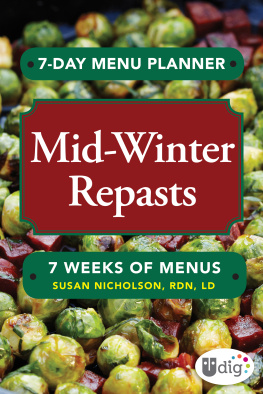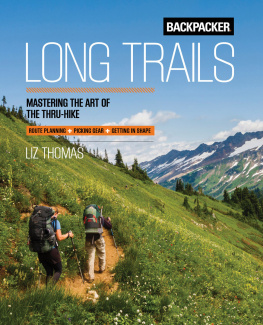
Third Vintage Books Edition, March 1986
Copyright 1976, 1978, 1985 by June Fleming
All rights reserved under International and Pan-American Copyright Conventions. Published in the United States by Random House, Inc., New York, and simultaneously in Canada by Random House of Canada Limited, Toronto. Originally published by Victoria House, Inc., in 1976.
Reprinted by arrangement with Victoria House, Inc., 2218 NE 8th Avenue, Portland, Oregon.
Portions of this work originally appeared, in slightly different form, in Wilderness Camping magazine.
Library of Congress Cataloging in Publication Data
Fleming, June.
The well-fed backpacker.
1. Outdoor cookery. 2. Backpacking. I. Title.
TX823.F58 1985 64l.578 84-40660
eISBN: 978-0-307-78753-8
v3.1
Preface
I have long enjoyed backpacking. There are so many pleasurable aspects: being in grand places that stun you with their beauty, the nestlike coziness of a good bed in your snow camp while a blizzard roars outside, stretching yourself sometimes to the limits of endurance or resourcefulness, the splendid waking process of splashing clear creek water in your face. All these facets of backpacking pleasure came to me in the earliest trail miles I walked and skied.
But the food! On these early treks the food was mainly functional, difficult and time-consuming to prepare, generally of mediocre quality and taste, and sometimes downright indigestion-producing. I didnt mind this terribly because I was still having a fine time. But I kept thinking: There must be a better way!
Gradually I gave more thought to what that way might be. I collected ideas from many sources, tried doing as much food-creating as possible and tested methods of organizing that would make for good eating without a lot of work or expense.
After several years of wilderness adventuring, of trial-and-error learning, I reached the point where experience and attitude joined to make eating in the wilds a distinct pleasure, an enjoyable challenge and an integral part of the whole process. I wished there had been a faster, more efficient way to reach that point. I wasnt discouraged from backpacking because of the lengthy learning process, but no doubt many have been.
So, I started sharing some of the learning through a course on backpack foods, and continued learning myself as others shared their ideas. Then came an intensive practicum course: a six-week ski trip through Oregons Cascades with three friends. We needed to plan and package 118 meals to be eaten in a variety of weather conditions. By the time we had gone through the home-preparation phase of those meals, we knew much more than short hikes could ever force us to learn. And an amazing thing happened! We hadnt used up the possibilities for good trail foods. We had become creative enough to find new ideas continually popping into our heads!
This book is an outgrowth of all these experiences, an attempt to share some ideas that I hope will increase your wilderness pleasure.
June Fleming
Portland, Oregon
April 1976
September 1984, eight years later:
Many moons, many miles, many meals have gone by. With them have come scores of new foods to choose from, dozens of tasty new recipes discovered with good trail friends, a few changes in how we eat and much more learning useful in the backcountry kitchen.
Im delighted to be able to share with you the bounty of these many wilderness seasons. May it please and fortify you body and spirit!
June Fleming
Contents
Introduction
E very backpacker, whether beginner or experienced, has his own way of planning and preparing meals for a trip. I want to share with you my way, which is
- eclectic drawing ideas from several sources, according to what fits best on a particular trip;
- not very precise striving for, but not usually worrying about, a good nutritional balance; not fussing much about measurements or cooking techniques;
- a lot of fun enjoying surprises, sharing, gifting, experimenting. The at-home part of backpacking foods (the creating, the organizing) gives me pleasure;
- not much work the part of backpack foods that happens on the trail (final fixing and eating) is kept simple and relatively quick;
- basically creative using some home-dried foods, some wild foods, some homemade foods and a lot of my ways of combining or using different foods.
Why should trail food be boring? With a little forethought and effort, the foods you tuck into your backpack will contribute solidly to the total venture, give pleasant surprises, be savored and remembered as part of the many-sided joy of being self-sufficient in the wilds.
Your wilderness pleasure begins long before the trip, as you build your basic fund of knowledge about what foods are available, which are suitable to take in your pack, how to combine them in ways that please you, what equipment fits with your particular style and needs, how to plan ahead so that what remains to be done on the trail is merely simple preparation and full enjoyment.
Your wilderness kitchen, with both its tangible and its intangible equipment, will be ready to go at any time, needing only the addition of a few meals or parts thereof drawn from your store of ideas. You may find yourself gathering food lists, recipes and one-liners (simple combinations of ingredients) into a file folder or notebook labeled Trail Foods, all set to yield inspiration later when you are planning an adventure on Vibram soles or cross-country skis.
Your freezer and cupboards may hold trail-portion packets of a special homemade granola, bars of pemmican, bags of gorp, smoked fish. You may begin to dabble in home-dried foods, thus adding one more dimension to trail eating with shelves stocked with lightweight, tasty and versatile fruits, vegetables, herbs and more.
This kind of approach extends the satisfactions of the wilds to include your at-home days. Now they are tinged with food discoveries to be utilized later. When the muse is with you and as time and budget allow, you can turn an ordinary workday evening or a rainy Sunday afternoon into a chance to prepare for wilderness trips not yet crystallized on your calendar. These practices give something of the same delightful feeling as studying topographic maps in front of your fireplace and learning in January the names and habitats of a dozen new plants you will first see in spring.
You have to eat when hiking, backpacking or skiing. But this need not mean chores youd just as soon avoid, undue expense to gain freeze-dried variety and ease of preparation, or fare that fuels you adequately but bores you in the process. Add something of yourself to the suggestions in these pages, keep on searching for new ideas and the pleasures of eating in the wilds will grow!
The Well-Fed Backpacker
is pleased and satisfied by the part of his wilderness experiences that have to do with food
has knowledge that enables him to plan, package and prepare foods for all kinds of trips










